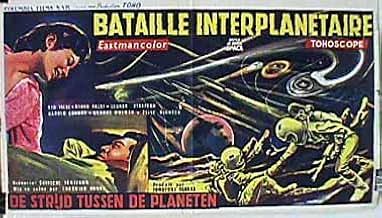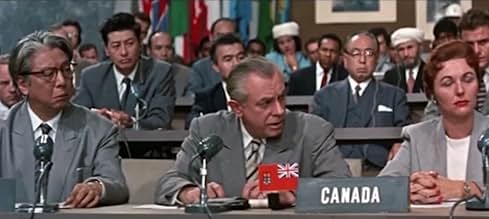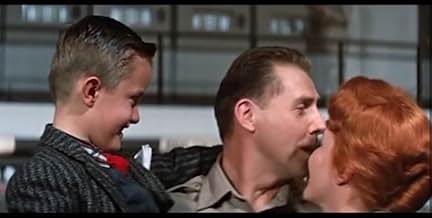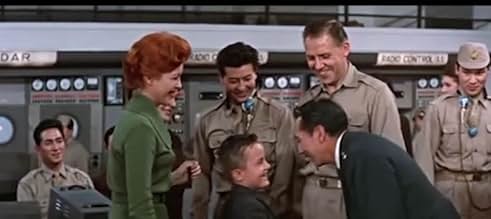IMDb रेटिंग
5.6/10
1.7 हज़ार
आपकी रेटिंग
अपनी भाषा में प्लॉट जोड़ेंThe nations of the Earth unite in a common cause to fight off an invader from outer space.The nations of the Earth unite in a common cause to fight off an invader from outer space.The nations of the Earth unite in a common cause to fight off an invader from outer space.
- पुरस्कार
- कुल 1 नामांकन
Ryô Ikebe
- Maj. Ichiro Katsumiya
- (as Ryo Ikebe)
Kyôko Anzai
- Etsuko Shiraishi
- (as Kyoko Anzai)
Harold Conway
- Dr. Immerman
- (as Harorudo Konwei)
Elise Richter
- Sylvia
- (as Erisu Rikutâ)
Hisaya Itô
- Kogure
- (as Hisaya Ito)
Nadao Kirino
- Gravity Man
- (as Hiro-o Kirino)
Kôzô Nomura
- Rocket Commander
- (as Kozo Nomura)
Takuzô Kumagai
- Alien
- (as Jirô Kumagai)
Katsumi Tezuka
- Alien
- (as Katsumx Tesuka)
Mitsuo Tsuda
- Air General
- (as Mitsuo Isuda)
- …
Osman Yusuf
- Bystander
- (as Osuman Yusefu)
फ़ीचर्ड समीक्षाएं
Battle in Outer Space brings back some happy memories. I recall seeing this movie at the local Strand Theatre. I was (10) years old at the time and it was such a revelation to see an outer space film in "Color". In those days most Saturday afternoon Sci-Fi was in B/W. True, there were a few high dollar efforts like War of the Worlds and Forbidden Planet but for the money, or lack there of, this "B" films brilliant colors & special effects (loved those jitter-bugging saucers)held its own with the big boys. I recently bought a Japanese DVD version at eBay, with English subtitles, and believe me it's just not the same as the dubbed English version. Forget the bad lip-sink, that "Voice of Doom" from the Natal Moon base is not nearly as ominous in Japanese. Glad to see others remember this little "B" gem too. Hope to see it properly released in DVD soon.
Aliens are causing havok on Earth. So a bunch of astronauts are sent to the moon to war with these little funny midget aliens. Just a big battle from beginning to end, with the aliens sucking up Tokyo at the end (man is that cool). It is basically like a Japanese Independence Day except not nearly as intense or violent
Pint-size aliens from the planet Natal are bent on conquering the Earth in this colorful space opera from the heyday of Toho Studios. Second in a trilogy of space-themed movies directed by the inimitable Ishiro Honda (the other two being "The Mysterians" and "Gorath") this is pure mindless fun.
The special effects may seem dated now, but for the time they were first-rate, much better than your average sci-fi and far superior to any of the monster films Toho cranked out from the mid-60s onward. This was definitely not done on the cheap: The sets are well thought-out, the astronomical backgrounds detailed and quite convincing.
Eiji Tsuburaya's intricate miniature work is amazing as always. The voyage to the Moon, the fight on the lunar surface, and the final showdown (with souped-up X-15s squaring off against alien saucers and a huge mother ship) are elaborately staged and exciting.
Which is why it's easy to forgive the occasional cheesy bits. For instance, when the beautiful SPIP rockets are taking off for the Moon, Honda illustrates the effects of high-G by having one of the crewmen put his hands on either side of his face and *pull* the flesh back. I also suspect they were running out of funds (the film's only 74 minutes long) when it came time to shoot the scene where the alien mother ship tears up downtown Tokyo with a gravity-reversing ray. Although it's a clever effect, apparently achieved by building the models on top of compressed air jets, the sequence feels too short. Plus the miniatures just don't look quite as detailed or realistic, when compared to other Toho films of the era.
My biggest complaint: In the one scene where you actually meet the aliens in the flesh (sort of) they're in spacesuits which make them look like midget Michelin Men and they sound like a bunch of squeaky dog toys. When a crowd of them "menaces" the heroine, there's not a ray gun in the bunch; all they can can do is shuffle, wave their arms and squeak. Not very intimidating, to say the least. (If anything, they're hilariously reminiscent of that roomful of sex-crazed Cub Scouts in Woody Allen's "Everything You Always Wanted To Know About Sex".)
But the good far outweighs the not-so-good in this romp. In a theater, in its original Tohoscope (Toho Studios' equivalent of Cinemascope), it must have been something to see.
(Update: In 2007, an outfit called Monsters in Motion released "Uchu Daisenso" on DVD -- in letterbox, in the original Japanese with English subtitles -- as part of their "Toho Masters" series. With its companion piece "Gorath" available from MiM, and Tokyo Shock's gorgeous edition of "The Mysterians", Honda's entire space trilogy is now obtainable in the original, unedited widescreen versions.)
The special effects may seem dated now, but for the time they were first-rate, much better than your average sci-fi and far superior to any of the monster films Toho cranked out from the mid-60s onward. This was definitely not done on the cheap: The sets are well thought-out, the astronomical backgrounds detailed and quite convincing.
Eiji Tsuburaya's intricate miniature work is amazing as always. The voyage to the Moon, the fight on the lunar surface, and the final showdown (with souped-up X-15s squaring off against alien saucers and a huge mother ship) are elaborately staged and exciting.
Which is why it's easy to forgive the occasional cheesy bits. For instance, when the beautiful SPIP rockets are taking off for the Moon, Honda illustrates the effects of high-G by having one of the crewmen put his hands on either side of his face and *pull* the flesh back. I also suspect they were running out of funds (the film's only 74 minutes long) when it came time to shoot the scene where the alien mother ship tears up downtown Tokyo with a gravity-reversing ray. Although it's a clever effect, apparently achieved by building the models on top of compressed air jets, the sequence feels too short. Plus the miniatures just don't look quite as detailed or realistic, when compared to other Toho films of the era.
My biggest complaint: In the one scene where you actually meet the aliens in the flesh (sort of) they're in spacesuits which make them look like midget Michelin Men and they sound like a bunch of squeaky dog toys. When a crowd of them "menaces" the heroine, there's not a ray gun in the bunch; all they can can do is shuffle, wave their arms and squeak. Not very intimidating, to say the least. (If anything, they're hilariously reminiscent of that roomful of sex-crazed Cub Scouts in Woody Allen's "Everything You Always Wanted To Know About Sex".)
But the good far outweighs the not-so-good in this romp. In a theater, in its original Tohoscope (Toho Studios' equivalent of Cinemascope), it must have been something to see.
(Update: In 2007, an outfit called Monsters in Motion released "Uchu Daisenso" on DVD -- in letterbox, in the original Japanese with English subtitles -- as part of their "Toho Masters" series. With its companion piece "Gorath" available from MiM, and Tokyo Shock's gorgeous edition of "The Mysterians", Honda's entire space trilogy is now obtainable in the original, unedited widescreen versions.)
This is Ishiro Hondas take on the classic space opera featuring alien invaders who have designs on Earth and will do anything to enslave mankind. This is a good, but not great, film. The only problem I have with it is that it tends to slow down during the scenes on Earth, especially the conference scenes. However, it picks up during the scenes on the moon and especially during the dogfight scenes featuring the rocket fighters battling the flying saucers. Also, in terms of acting, the best performance in this film definitely belongs to the great Yoshiyo Tsuchiya. Tsuchiya is excellent as the scientist who becomes possessed by the aliens, but becomes a hero who sacrifices himself after he is released from the alien control. He definitely makes this film more watchable.
Usually, one Ishiro Honda's science fiction films use two distinct themes. The first one is using his films as thinly veiled commentaries on socio-political issues (nuclear war, greed or commercialism) and the second is the world getting together for a common purpose. This film definitely follows the latter to a tee. This is definitely one where Honda uses his skill as a director to convey his wish that man would pull together for a common good instead of waiting until a major crisis to come together.
All in all this was a good film, but not a great one, but I still recommend it.
Usually, one Ishiro Honda's science fiction films use two distinct themes. The first one is using his films as thinly veiled commentaries on socio-political issues (nuclear war, greed or commercialism) and the second is the world getting together for a common purpose. This film definitely follows the latter to a tee. This is definitely one where Honda uses his skill as a director to convey his wish that man would pull together for a common good instead of waiting until a major crisis to come together.
All in all this was a good film, but not a great one, but I still recommend it.
Ishiro Honda is the Steven Spielberg of Japan in that he created a huge body of work...big, exciting, fantasy movies of such number, quality and iconic value that he stands head and shoulders above his peers.
This film is among Honda's lesser known works, and is a rarity in that there is absolutely no Kaiju in this film, not even a robot Kaiju such as seen in the better-known 'The Mysterians'. And, in terms of the fantastic cinema of Japan, this is one of the more serious science fiction creations of the period, although containing many inaccuracies that would be glaring to anyone with the slightest familiarity to the work of George Pal.
This film features creative and interesting FX that vastly outshine most of what the US was producing at this time, and might even have the most complex miniature sets and sequences of anything produced by Toho during the classic period. There are large scale space ship dogfight sequences that anticipate Star Wars, which was done 17 years later.
The plot, while not profound, is sufficiently interesting and entertaining and the actors are good enough to make this an enjoyable escapist film. Thematically, this is classic Invasion Literature, with few new wrinkles thrown in...definitely straightforward, Honda doesn't give us anything ambiguous or subversive to chew over.
Any fan of old-school scifi and Kaiju films is liable to enjoy this one very much, it's just an impressive spectacle.
This film is among Honda's lesser known works, and is a rarity in that there is absolutely no Kaiju in this film, not even a robot Kaiju such as seen in the better-known 'The Mysterians'. And, in terms of the fantastic cinema of Japan, this is one of the more serious science fiction creations of the period, although containing many inaccuracies that would be glaring to anyone with the slightest familiarity to the work of George Pal.
This film features creative and interesting FX that vastly outshine most of what the US was producing at this time, and might even have the most complex miniature sets and sequences of anything produced by Toho during the classic period. There are large scale space ship dogfight sequences that anticipate Star Wars, which was done 17 years later.
The plot, while not profound, is sufficiently interesting and entertaining and the actors are good enough to make this an enjoyable escapist film. Thematically, this is classic Invasion Literature, with few new wrinkles thrown in...definitely straightforward, Honda doesn't give us anything ambiguous or subversive to chew over.
Any fan of old-school scifi and Kaiju films is liable to enjoy this one very much, it's just an impressive spectacle.
क्या आपको पता है
- ट्रिवियाThis film was the first Japanese science fiction film which had the original Japanese cast and crew listed on the posters and other advertising material in the United States.
- गूफ़The funniest bits are the gravity antics. When the first scout ship turns off the thrusters and the crew all unfastens their safety belts, one of them flies up to the ceiling. He is so surprised, clearly no-one told this astronaut that there was no gravity in the spacecraft. They help him down and the chief tells him that there is no gravity in the ship. Then they all begin walking around completely normally.
- इसके अलावा अन्य वर्जनThe final 16mm prints struck for U.S. television distribution had the final third of the film letterboxed for the widescreen Tohoscope format.
- कनेक्शनFeatured in Aweful Movies with Deadly Earnest: Battle in Outer Space (1966)
- साउंडट्रैकBurlesque-style Rondo
Composed by Akira Ifukube
टॉप पसंद
रेटिंग देने के लिए साइन-इन करें और वैयक्तिकृत सुझावों के लिए वॉचलिस्ट करें
- How long is Battle in Outer Space?Alexa द्वारा संचालित
विवरण
- रिलीज़ की तारीख़
- कंट्री ऑफ़ ओरिजिन
- भाषाएं
- इस रूप में भी जाना जाता है
- बाहरी अंतरिक्ष में लड़ाई
- उत्पादन कंपनी
- IMDbPro पर और कंपनी क्रेडिट देखें
- चलने की अवधि1 घंटा 30 मिनट
- ध्वनि मिश्रण
- पक्ष अनुपात
- 2.35 : 1
इस पेज में योगदान दें
किसी बदलाव का सुझाव दें या अनुपलब्ध कॉन्टेंट जोड़ें














